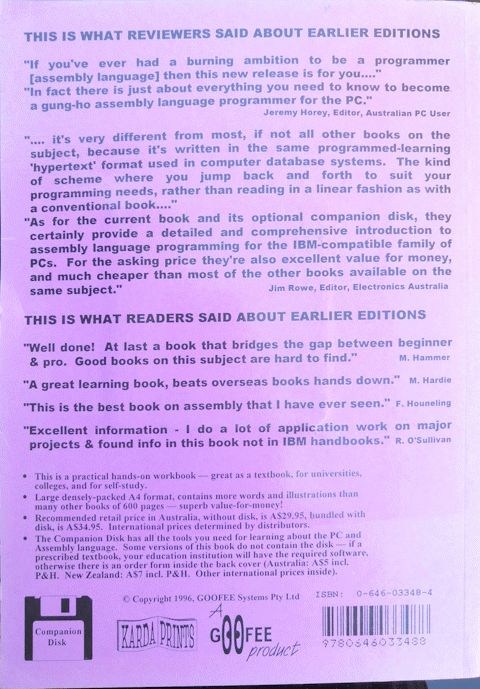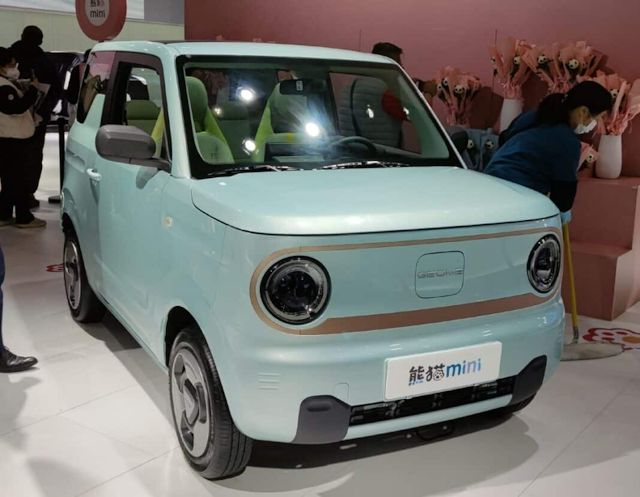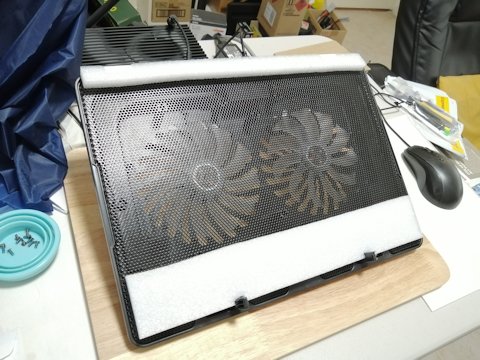Replacement UPS on order
I own a CyberPower Value1500ELCD, rated at 900W, I think purchased in 2018. Still on the original battery, actually two batteries, each lead-acid 12V 9AH, wired in series. The mains power dropped out for a few minutes recently, and the UPS did its thing, so the batteries are still working.
Now here is the odd thing...
Being ultra safety-cautious, I always turn off the computer, then the UPS, then the mains switch. When do the reverse, flick the mains switch on, then press the UPS button, wait a moment, then the power button on the PC. The new "event" now, is my PC makes a loudish noise, the fan runs for a moment, then turns off, then a few seconds later the fan starts again and there is normal bootup -- except that the date in the CMOS has reset to January 1, 2017. This is happening everytime.
Yet, if I turn off the PC and UPS, but leave the mains switch on,
next time turn on the UPS and PC, it starts up correctly.
At first I suspected the button-cell lithium battery on the PC
motherboard, so replaced that. No difference.
Then I noticed that the UPS case is very hot. Under normal operation, the UPS will just be doing pass-through of the mains, and should be cool. I removed the UPS entirely, now running without a UPS, and my PC starts up as it should, perfectly OK.
I opened up the UPS and noticed that the batteries are hot. That indicated to me that the batteries are being over-charged. So maybe the batteries are failing, though as observed in recent power outage, they do still work. Right, so looked up the price of 12V 9AH batteries, AU$39.95 each from Jaycar, a local shop:
https://www.jaycar.com.au/12v-9ah-sla-battery/p/SB2487
...80 bucks, when I don't even know for sure if the batteries are the cause of the fault!!!
Looked on eBay, saw lots of cheap UPSs, and ordered this, CyberPower VP700ELCD, for AU$149 including delivery. Paid an extra AU$5 for express delivery:
https://www.ebay.com.au/itm/334624152827

OK so it's only 390W, but enough to run my PC and monitor. Doesn't say, but probably has just one lead-acid 12V 9AH battery -- that's what most of the budget UPSs have.
Yeah, that's the way it is, simpler just to buy a new UPS, rather
than attempt to fix the old one. As an electronic engineer, in my
younger days I would have kept the old UPS for spare parts --
lovely heatsinks in it -- but now, the batteries are going to a
local battery-recycling bin and the rest of the UPS into the
trash. Which is a shame.
Tags: tech
Motorola Moto G75 phone
Bought this today. Reason, want to make videos for YouTube, and
my current phone (until today) can do 1080p at only 23.98 fps
(frames per second) -- even though the documentation says it will
do 30 fps. 1080p is OK, but want higher frame rate.
A couple of days ago, posted about first video upload to YouTube:
- PupMTP file transfer, first video — November 17, 2024
I bought my Huawei Y9 in January 2020, so almost five years old. It is still working and the battery is still good, though it has been recharged daily for five years. Don't like to waste a good phone, but now it will be a backup. So the hunt was on for a new phone...
Want a phone that will do 1080p at 60 fps, and with image stabilization. OIS (Optical Image Stabilization) looks good. There are flagship phones that have lots of features but very expensive. But, I only want to spend just enough to get 1080p @ 60 fps and OIS; the cheapest that I could locate, that is sold locally, is the "Motorola Moto G55 5G"; however, it only has 4GB RAM.
My Huawei phone has 4GB RAM and I don't have any problem with that, but these days even fairly cheap phones have 8GB RAM. So ruled out the G55, though the AU$299 price is very attractive. Going up in price, narrowed it down to these two:
- Nothing Phone 2a 5G
- Motorola Moto G75 5G
The Nothing Phone looks good, a lot for the price; however, two things ruled it out. Price, yes, only AU$426 (128GB storage) or AU$496 (256GB). The two things that ruled it out for me:
- A couple of users reported bubbles forming on the edges of the display. Maybe this was just an early production problem.
- Dimmed screen uses PWM 2160 Hz.
Point-2 is very interesting. Many OLED and LCD screens use PWM (Pulse Width Modulation) to dim the screen. What this does is turn the pixels on and off very rapidly, such that the overall effect for your eyes is that the screen looks dimmer. What does this do to your eyes though, full brightness, then off, alternating rapidly? It leads to eye strain and headaches.
Apparently, some good quality phones use DC dimming. That is, the
DC voltage fed to the pixels is reduced, hence the screen becomes
dimmer.
The Nothing Phone 2a has an AMOLED screen. I did some online searching and found that the Nothing 2a phone uses DC dimming down to 50% brightness, and below that uses PWM at 2160Hz. See here, though, they describe above 50% as "DC-like" which I don't understand:
https://www.youtube.com/watch?v=-A5h7UynfnQ
The Motorola G75 has an IPS LCD screen, and I discovered that it uses PWM for dimming, but at a very high frequency; 40,000Hz. See here:
https://www.reddit.com/r/PWM_Sensitive/comments/1gbunmt/moto_g75_opple_results/
The high frequency is apparently easier on the eyes, though personally I remain to be convinced. Anyway, bought the G75.
Very nice phone. Flat screen (I dislike screens with curved edges), 8GB RAM, 256GB storage, 50MP main camera with OIS, records up to 4K (UHD, 2160p) at 30 fps. etc. Specs here:
https://www.gsmarena.com/motorola_moto_g75-13372.php
Motorola's webpage:
https://www.motorola.com.au/smartphones-moto-g55-5g//smartphones-moto-g75-5g/p
Here is a YouTube video:
https://www.youtube.com/watch?v=DdrnGTm7AKI
The G75 is very new, only got released in Australia this month.
Cost was AU$497, including ear-buds and a soft plastic protection
back. Some dramas transferring data from my old phone, as I don't
use online sync'ing; was able to do it via a USB
cable.
Tags: tech
PC Architecture & Assembly Language book
Wow, this has brought back memories! I received a message on the Puppy Forum from Colin. Here it is:
Hi Barry,
This message has been on my list for a long time, but for some
reason I've never got around to sending.
I was a student in your Microprocessors class at Edith Cowan
back in 1993, and it genuinely was my favourite during my
undergrad degree (which ironically was not a science or IT
major) and was absolutely the fuel that elevated my interest in
computing beyond hobbyist. While I spent the better part of
20yrs in law enforcement, I eventually left government and
transitioned to cyber security, making use of the fundamentals I
learned in your class, and even referring to your book again
when starting to dabble in malware analysis.
After almost 10 years abroad doing a variety of digital forensic
work, when I returned to Australia last year and unpacked some
boxes I again discovered your Assembly book among the few that I
kept. It sits proudly on my bookcase as a reminder that a strong
technical base goes a long way.
Thank you for your course, your enthusiasm as a teacher and for
the spark that took to me down a different path and a mentally
stimulating career living and working in places I never
expected.
I hope that you are well, and from your site it appears you are
enjoying pursuing both new and old interests.
Regards,
That book was initially, self-published, then got taken up by a publisher in the UK. They published the Third Edition. I retained the rights in Australia, and went on to release the Fifth Edition in 1996. The book was stocked in Dick Smith electronic stores throughout Australia and New Zealand, and was very popular.
At the Fifth Edition, I decided to pull the plug on it, and wrote to Dick Smith that was discontinuing it. Someone from Dick Smith phoned me and expressed disappointment as it was a good seller.
Those were the days of printed books, and people still wrote letters. I literally received hundreds of written testimonials (and emails) from people who loved the book, like Colin.
Snapshots of the Fifth Edition, front and back:

Back:

The book was prescribed at my university as well as a couple of other institutions. And that's where there is a somewhat bitter memory...
There was this subject, "Microprocessors" that I prescribed my book as the textbook. Fine, I received feedback like Colin's. However, one day a student came to the door of my office and proceeded to tell me how shitty my book was. Which came as a complete surprise, an opinion so totally at variance with all prior feedback.
What I found out was one of the lecturers was intensely jealous and was badmouthing the book to his students and other staff. The Microprocessors unit was a first-year unit and taken by many students, so there were parallel classes, including taught by that particular lecturer.
The thing is, I wasn't one of the boys, never went to the staff room at tea/lunch breaks, so was never part of the gossiping. Actually, there were two of them who were jealous. I was incredibly naive back then, and when discovered these back-stabbers was shocked, and lost interest in working at the university.
One of them used to be Coordinator for Microprocessors, but the
Head of Dept. took it away from him, gave the role to me. Another
reason for him to have a lingering resentment.
The last couple of years there, just went through the motions,
lacklustre performance, and resigned. To be more precise, I was
not tenured, on 3-year contracts, and resigned in the second year.
Then one of the senior lecturers asked if I would come back for
one more year, so I did, signed a one-year contract.
I am mentioning this negative memory, as it has in it an important lesson, that another young and aspiring young person who might read this, should learn.
Don't take the above as complaining. No, it was a lesson in life, and I learned from it. What is the lesson? Well, it depends whether you are in a competitive environment of not. If so, and you don't excel relative to your peers then you are OK, otherwise be wary. Also, don't be an outsider, like I was; be pally with the bosses!I should mention something else, as contrast. I lectured at a
couple of technical colleges for 5-6 years, and my peers were such
a laid-back easy-going bunch of guys. Good memories.
After that book, I wrote "Windows Assembly Language & Systems Programming", that was published by an international publisher. Then wrote "Flow Design for Embedded Systems", followed by a 2nd edition.
I see that secondhand editions of my books are still available, though I wouldn't recommend them these days. The two systems programming books are just too old. "Flow Design for Embedded Systems" 2nd edition is still in print I think -- I was receiving royalty checks up until a couple of years ago, then I asked them to just give it to a charity, as the checks were too small to process.
Just now checked, yeah, looks like the flow design book is still being published:
https://www.amazon.com.au/Flow-Design-Embedded-Systems-Object-Oriented/dp/087930555X

That was a new paradigm for graphical code design, with C code generation. Particularly good for creating little operating systems.
However, it never caught on, I think because too esoteric. At the
time, early 2000s, I lost interest in it. Typical of me back then;
intensely interested in something for awhile, then just dropping
it. Went on to create "Embedded Vector Editor" (EVE), then circa
2002, Linux, then Puppy.
I picked the book up a few months ago, wondering if I should
revisit the topic, but actually had trouble understanding what I
had written! Could get back into it, as know some improvements
that could be made, but still too much involved in EasyOS, don't
have the time for anything else.
Tags: tech
Chinese mini electric vehicles amazingly cheap
I mentioned in a recent post about "The Electric Viking" videos
on YouTube -- an Australian guy who posts about electric vehicles,
battery technology, car companies, and anything else related.
He posted about tiny EVs in China selling for under US$6,000, so I
hunted around for further information. Lots of promotional material
online, but I wanted to see a video that shows them in use; the daily
experience. I found this great video; a Canadian guy who visited a
factory to see them being made, and he got to drive one:
"Tesla being crushed by China's mini EV"
https://www.youtube.com/watch?v=RiXljigqRg0
...absolutely fascinating. Car bays with charging stations, costing
one Canadian dollar to drive 100km. That's AU$1.10 and US$0.75.
Here in Australia, we have fragmented charging stations. Tesla
stations that other EVs are not allowed to use. Expensive charging --
there was a recent test here, a diesel-engine car and an EV drove
1,400km, and the diesel-engine car cost less for the trip.
Over one million of these little cars have been sold in China, but
they are only now starting to appear overseas. One model has just been
introduced in Indonesia; the Wuling Air.
A photo of the Geely Panda Mini EV:

In Australia, electric vehicles are over AU$45,000; why so expensive?
I did see a report that Tesla is developing a cheaper car, apparently
it will be about US$25,000; but that is still expensive compared with a small ICE car.
Here in Australia, we live in a "Nanny State", with very restrictive
safety regulations, that keep getting more restrictive. There is an
insurance company here, RACWA, that won't insure any vehicle with a
safety rating under 4 stars -- yet they will insure motorcycles -- to me
that seems hypocritical -- as are the government safety regulations.
I looked around for a crash test of these mini EVs, The Electric Viking has one:
"The EV that will change the world crash tested -- is it SAFE?"
https://www.youtube.com/watch?v=X1Vh2B0Rix8
...yipes, no airbags!
Twenty years ago, lack of airbags here in Australia would have been
OK. But I reckoned the Chinese would be aware of the need for increased
safety to reach international markets. Yes, look at the Panda Mini EV:
"Geely Panda Mini EV"
https://carnewschina.com/2023/02/01/the-geely-panda-mini-ev-opened-for-pre-sale-and-will-launch-on-february-6/
...driver's side airbag. The electronics looks impressive. 100km/h top
speed, OK for city driving. 120km or 200km range, again OK.
Hmm, it might even scrape in to meet the minimum safety legislation
in Australia. Don't know about one airbag though.
Tags: tech
Lots of promising new battery technology
After today posting "Electric vehicle reality check", thought perhaps a good idea to do another post with a more positive slant:
https://bkhome.org/news/202212/electric-vehicle-reality-check.html
Lately, have been reading about promising new battery technologies. Some of them will alleviate the environmental disaster that is lithium mining and processing. Some are safer, faster to charge, more recharge cyslces, deeper discharge, etc.
For stationary storage, there is the Gelion battery, which can never catch fire, can be discharged to 0%, environmentally friendly and low cost:
https://createdigital.org.au/australian-developed-stationary-battery-safer-and-greener/
...they have started small-scale production at a factory in Victoria, Australia.
For an alternative technology for stationary storage, how about this; gravity storage using 35-tonne blocks:
There are always new announcements of fantastic battery technologies for electric vehicles, but what has caught my attention is sodium-ion:
https://www.youtube.com/watch?v=QZdWxWtQBHs
...how much of this is hype?
Actually, what got me interested in sodium-ion batteries was a post by this guy, in his "Just have a think" series:
https://www.youtube.com/watch?v=cHNELRnJ_4Y
...he does sober, unbiased, non-hype assessments.
It was on the news here a few days ago, someone's house burnt down, when they left a lithium-powered skateboard on charge. Spontaneous combustion and explosion of lithium-ion batteries is quite common, so we really do need an alternative.
I guess as 2023 progresses, we shall see how true the uptake of sodium-ion battery becomes. If the YouTube posts are to be believed, the Chinese company CATL is already building huge battery production plants in China and Europe, with cars due to hit the streets in 2023.
Interesting times, hey!
Tags: tech
16GiB RAM module works in Aspire 3
I have posted about the Acer Aspire 3 Ryzen 5 experiments:
- Radical experiment to cool the laptop — December 20, 2022
- Enhancing the Acer Aspire 3 Ryzen 5 laptop — December 13, 2022
- Acer Aspire 3 Ryzen 5 3500U laptop — December 12, 2022
As reported, it has 8GiB soldered onto the motherboard and 8GiB in a SODIMM card.
Online searching revealed very little information whether the laptop will support anything larger than 8GiB. The Acer official docs state that 8GiB is the maximum. One user reported a 16GiB SODIMM module worked, but he had problems with 32GiB -- no details provided.
I would like to report that a 16GiB module works, or at least has worked with limited usage. Bought this one, described as "Kingston 16GB DDR4 valueRAM SO-DIMM 2Rx8 CL22 3200MHz":
https://www.ple.com.au/Products/647696/kingston-16gb-ddr4-valueram-so-dimm-2rx8-cl22-3200mhz
And for the record, my laptop is Acer Aspire 3 Ryzen 5 3500U A315-23-R7UL, model N18Q13.
The 'free' utility shows total RAM is 21.46GiB, so I suppose
3.54GiB has been carved off the 8GiB soldered-on RAM for use by
the GPU.
Tags: tech
Radical experiment to cool the laptop
I posted about an OpenEmbedded compile with the CPU set to "powersave" mode and all CPUs running at 1400MHz:
https://bkhome.org/news/202212/enhancing-the-acer-aspire-3-ryzen-5-laptop.html
Just let it run, compiling the entire 1,620 packages... it took 4 days and 3 hours!
As mentioned in that post, OE was set to use only 3 threads, also compiling of each package was with "make -j2", that is, only using 2 threads.
Decided to try a radical experiment, bought a tilted fan stand from Kmart, only AU$15 (about US$10):
https://www.kmart.com.au/product/laptop-stand-with-fans-43026623
The stand is plastic, however the fans are covered with a metal mesh, so applied closed-cell packaging foam top and bottom to provide some separation:

Took the back plate off the laptop, so that the fans will be blowing directly onto the components inside the laptop.
Wanted to recompile Chromium, as made some changes to the build recipe. Chromium takes the longest to compile and is a severe resource hog. It eats up the RAM. 16GB is needed, though the Aspire 3, my one anyway, shares that with the GPU, so more likely only about 14GB available.
I read one guy reported running out of storage when he had 32GB RAM, but he had set a high number of threads -- don't recall the number. Anyway, decided to leave "make -j2", given my laptops low RAM.
This time, set the CPU to "userspace" mode and set all CPUs to 1700MHz. Then started the recompile of Chromium. In the tray, CPU temperature was ranging from 70°C to 79°C. Summer here, and ambient temperature was probably varying between 25 and 28 -- not sure, as didn't actually measure it.
Chromium took about 20 hours to compile.
How to improve this? Increase that "make -j<n>", but the laptop will probably need more RAM. According to the offical Acer docs, it is already maxed-out, with 8GB soldered on the motherboard and 8GB on a SODIMM card (Samsung 8GB 1rx8 PC4-3200AA).
After an online search, did find posts some guys were able to increase that. One guy said that a 16GB RAM card worked, but there were problems with a 32GB card. No details were provided.
For example, what would be best, a 16GB 1rx8, 2rx8, or 1rx16? I read that x16 cards are bad news. My local computer parts shop has a 2rx8, so will probably try that. That will bump the laptop to 24GB, take off about 2GB for the GPU.
Right, so likely that will be the next experiment. Put the cover back onto the laptop, but still use the fan-stand. Bump the RAM with a 16GB SODIMM card, and try compile Chromium with more threads.
There is very good reason why I set "make -j2" globally for OE. In the past, a higher figure caused some package builds to fail. However, it can be set on a per-package basis, so I could try, say "-j4" for Chromium only. That may considerably speed up the build, but may also result in the CPU running hotter.
One interesting note: most Aspire 3 laptops only have 4GB RAM soldered onto the motherboard. I looked at aliexpress.com, and all the replacement motherboards for my Aspire 3 Ryzen 5 A315-23 only have 4GB RAM. The Aspire 3 family has incredible variability. Acer have used a common housing, screen, etc., with an incredible variety of models.
It is very interesting to experiment with this Ryzen 5 3500U CPU. It supports 1400, 1700 and 2100MHz frequencies, but also has a turbo, or boost, 3700MHz. I think, before had set the CPU to fixed frequencies, that turbo-mode was kicking in, which pushed the temperature to 90°C and over, and the fan to maximum speed. Note that turbo-mode can be turned off, by doing this:
# echo "0" > /sys/devices/system/cpu/cpufreq/boost
...I noticed that my Intel i3 CPU doesn't have that
"boost".
Tags: tech
